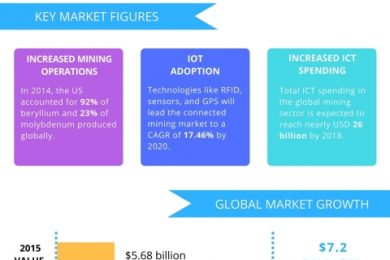Technavio analysts forecast the global connected mining market to grow at a CAGR of more than 17% during the forecast period, 2016-2020, according to its latest report. The research study covers the present scenario and growth prospects of the global connected mining market. To determine the market size, the study considers revenue generated from surface mining and underground mining.
Connected mining refers to the use of technology to achieve better productivity and safety, as well as reduce operational costs for a mine site. It includes remote-controlled robotic machinery for mineral extraction.
The global connected mining market was valued at $5.68 billion in 2015. Geographically, APAC leads this due to rapid growth in manufacturing, steel, construction, and other industries. Countries in this region are allocating extra resources to the connected mining market to reduce their dependence on imports. Availability of enhanced network infrastructure will push the connected mining market growth in the region.
Technavio analysts highlight the following four factors that are contributing to the growth of the global connected mining market:
• Increased global mining operations
• Reduced price of connected devices
• Increased adoption of IoT
• Increased availability of advanced aerial imagery.
Increased global mining operations
“Minerals and metals play a crucial role in daily operational activities. Depleting mineral deposits have led to in technological advances to facilitate the exploration of previously inaccessible mining deposits. The development of large ocean-going vessels, which were initially constructed to transport crude oil, is also facilitating the global trade of bulk mineral commodities, such as iron ore and bauxite”, says Abhishek Sharma, one of the lead analysts at Technavio for connected devices research.
Coal, mineral, and metal mining equipment vendors are trying to manufacture energy-efficient mining equipment to adhere to energy-saving policies enforced by countries. Atlas Copco introduced The Green Line, which comprises two electric underground trucks, four electric underground loaders, and new portable generators, in a bid to regain its footprint in the market. The trucks in this line can lower the total cost of ownership by 50%. The electric loader replaces a 10-t diesel loader, reduces emissions, and consumes less energy. Developments like this will play a significant role in propelling the growth of the global connected mining market.
Increased adoption of IoT
Internet of things (IoT) brings together several technologies like radio frequency identification (RFID), sensors, and GPS under one category. With IoT, every device or asset in an organization is connected with othe assets within that organization. In addition, enterprises are showcasing a significant growth in business processes with the adoption of the IoT. Closer monitoring of business processes will lead to more effective decisions in real time.
The mining industry requires long-term cost reductions and increased levels of productivity and efficiency. By utilizing integrated automation services and control systems, organizations can employ driverless trucks, real-time monitoring of productivity data, and supervisory control of mining operations from remote operations centres thousands of kilometres away. IoT services play a major role in tackling supply chain challenges and improving overall efficiency, which, in turn, boosts the profitability of the organization.
Reduced price of connected devices
“Numerous low-cost and energy-efficient wireless sensor nodes are being used in IoT systems, which have become an integral part of M2M or IoT communications in connected mining. The decline in hardware prices, installation costs, and the tariff rates of network operators is also triggering an increase in the deployment of M2M safety systems”, says Sharma.
In the mining industry, these sensors enable autonomous trucks to safely operate in critical situations in coordination with a GPS system, an obstacle detection system, and a wireless network system. These autonomous systems can also integrate dozers, loaders, and shovels with each other to allow unmanned operation of mining operations. Autonomous haulage systems boost mining truck safety and productivity. Highly advanced safety systems enable autonomous haul trucks to operate reliably in and around other mining equipment and light vehicles.
Increased availability of advanced aerial imagery
High-resolution digital satellite aerial imagery has gained popularity in mapping for most land applications. The information is used for analysis, strategic planning, and evaluation in engineering and urban planning. Aerial imagery provides a lot of information about a project site that cannot be ascertained from the ground level. These images provide a way to effectively monitor and plan the workflow.
Mining companies use the information from aerial imagery to document the construction status and avoid unnecessary latencies. Developers can use aerial imagery to study the causes of development planning issues including traffic congestion, overcrowding of buildings, and district heating. Also, aerial imagery helps to identify remote mineral and metal resources at unmanned locations to automate mining operations.










